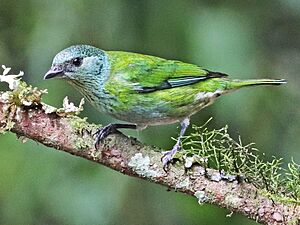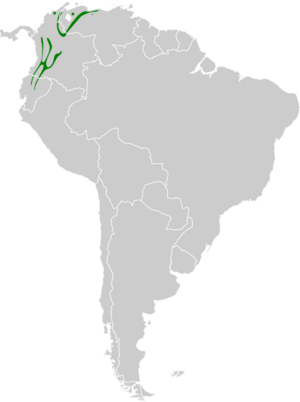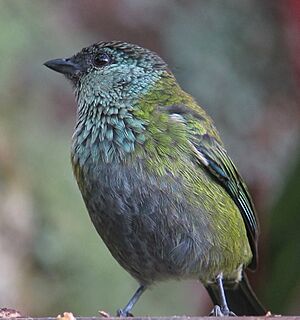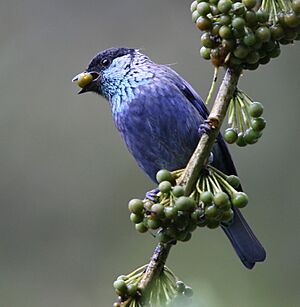Black-capped tanager facts for kids
Quick facts for kids Black-capped tanager |
|
|---|---|
 |
|
| Male, photographed in northwestern Colombia | |
 |
|
| Female, photographed in northwestern Ecuador | |
| Conservation status | |
| Scientific classification | |
 |
The black-capped tanager (Stilpnia heinei) is a beautiful bird found in the mountains of Ecuador, Colombia, and Venezuela. It's part of a large bird family called Thraupidae, known as tanagers. These birds live in warm, wet mountain forests all year round. You can often spot them alone or in pairs, hiding among tree branches and bushes. They like open areas and places where forests used to be.
Contents
About the Black-capped Tanager's Family
The black-capped tanager was first described in 1851. It belongs to a group of birds called Stilpnia, which is part of the tanager family, Thraupidae. In Spanish, people sometimes call it "Tangara gorrinegra." This bird is a songbird.
Tanagers are a very diverse group. There are over 300 different kinds! They make up more than 10% of all birds in the Neotropics. The name Stilpnia was suggested in 2016. This was to show how tanagers are related to each other based on their DNA. The black-capped tanager is most closely related to the straw-backed tanager (Stilpnia argyrofenges).
The International Ornithologists' Union (IOC) officially calls this bird the "black-capped tanager."
What They Look Like
The black-capped tanager is about 13 centimeters (5 inches) long. It weighs between 18 and 20 grams, which is about as much as a few quarters. Its eyes are dark brown, and its beak and legs are black.
Male Tanagers
Male black-capped tanagers have a shiny black cap on their head. This black color goes down to their forehead and the back of their neck. Their upper body is a bright, silvery bluish-grey. This color stands out against their black cap. Their wings are a duller bluish-grey with blue edges.
The male's throat, neck, and chest are a sparkling aquamarine-green. The feathers in this area have dark bases, which makes them look a bit streaked or scaly. The rest of their underside is a dull greyish-blue.
Female Tanagers
Female tanagers look a bit different. Their cap is dusky, with green edges on the feathers. This gives their head a slightly scaly look. Their upper body is a uniform, shiny green. Their tail is a duller green or olive-green.
The female's wings generally appear green. Her underside is similar to the male's but duller. Her throat, neck, and chest are green with a scaled look. The rest of her underside is grey.
Young Tanagers
Young male tanagers look somewhat like females. However, they have a pale blue edge on their primary feathers. Very young birds of both sexes are duller than adult females. Older young males start to show some adult male feathers. This means they might have a mix of green and black on their crown.
Similar Birds
The black-capped tanager looks a bit like the silver-backed tanager (Stilpnia viridicollis). Females of these two species are especially similar. But the silver-backed tanager female has a coppery throat, not a green one. The beryl-spangled tanager (Tangara nigroviridis) is also similar. However, it doesn't have a dark cap and its underside is more sparkly.
Their Song
Unlike some other tanagers, the black-capped tanager sings often. It doesn't seem to prefer singing at any special time of day. It usually sings from a high spot. Their songs can be up to ten seconds long. They have a low, ringing sound, often described as "t'kling-t'kling-t'kling." They also make high-pitched calls like "zheet" or "tsit."
Where They Live
Black-capped tanagers live in wet mountain forests. You can find them in northern Ecuador, Colombia, and Venezuela. They prefer the edges of these forests. They also live in younger forests and in trees and bushes in open areas nearby.
These birds are usually found at heights between 1,500 and 2,200 meters (about 4,900 to 7,200 feet) above sea level. They live in the Andes mountains in Colombia, Venezuela, and Ecuador. In Ecuador, they were first seen on the western side of the Andes in 1980. This might mean they have spread their range because of forests being cut down.
How They Live
You can find black-capped tanagers alone or in pairs. They often hide under branches. They behave much like other mountain tanagers. However, they are more often seen looking for food in open areas, even outside the forest. They also tend to forage in pairs, not always with large mixed groups of birds.
What They Eat
Different kinds of tanagers can feed together without fighting for food. This is because each species looks for food at different heights in trees. They also use unique movements to find food. The black-capped tanager mainly looks for insects in low bushes and trees. It stays close to the tree trunk or on branches covered in moss. This bird also eats fruits, like whole berries.
Raising Young
During wetter times of the year, both parent birds help feed their young. They also work together to build the nest. However, the male doesn't always help build the nest. The outside of the nest is usually made of small roots and lichen. Spider webs and egg sacs hold it all together. The inside of the nest has lichen, roots, and grass strips.
To make the nest a cup shape, the female presses her body into it and vibrates. The female sits on the eggs for about 14 days to keep them warm. While she is brooding, the male will sometimes bring her food. If a predator, like a green jay, comes near the nest, the female will sink down into it to hide.
Protecting the Black-capped Tanager
We don't know the exact number of black-capped tanagers in the world. However, they are described as being uncommon in the areas where they live. There's no clear sign that their population is shrinking. Because of this, the International Union for Conservation of Nature (IUCN) listed them as a species of "least concern" in 2018.
This might be because black-capped tanagers can live in forests that have been disturbed by humans. So, they might even benefit from some human activity. However, if people get too close to a nest, the female might stop sitting on her eggs. This could be a problem for the birds in the future.




